
Yulia Olennikova
ABM Challenges And Real-Life Stories Of Overcoming Them
"We need to implement ABM this year", "our absolute priority is to set up an account targeting strategy", "ABM is the only approach that will work in B2B" - you've probably heard this from your manager or read from numerous LinkedIn influencers (which your manager is following too). But what those influences usually don't mention are the challenges you'll face on your ABM journey.
In order to get you prepared, we asked marketing and sales experts from B2B start-ups, scale-ups and agencies about their main struggles with ABM - and what they're doing to overcome them. Read on for some real-life stories, tips and shortcuts!
Challenge 1. Getting Buy-In For ABM
Account-based approach isn't something you can briefly experiment with. In order to make it work, you'll need:
- Approval of marketing, sales, and operations
- Budget approval (ABM tools aren't cheap)
- Understanding of a necessary time lag - it takes at least several weeks, more often months, to see the results
How do you make sure every team is committed enough without a massive change to their work processes?
Solution: Start small with a pilot campaign
Elroy Messelaar, ABM Marketer at Webs, suggests involving everyone in a small, pilot ABM campaign with transparent and shared goals.
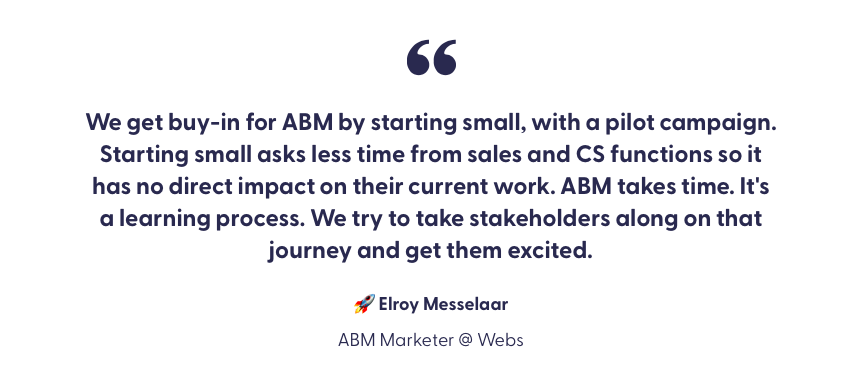
As an example, you can run a very focused campaign for 100 accounts from the same industry in the same country. It will require limited resources and will allow testing the ABM approach quickly:
- All teams involved need to define only one selling prop that is super relevant to those particular companies in this particular location. For example, you decided to target UK companies whose ICP is marketing and SEO agencies - your unique selling proposition can be "the biggest database of marketing agencies in the UK".
- Marketing has to prepare a limited number of collaterals, focusing on just one vertical and one location.
- Sales need just a few scripts.
- Operations have crystal clear understanding of accounts to focus on in the campaign.

N.Rich Segment Builder
After the pilot campaign starts generating results, it's easier to get a buy-in for additional tools and resources.
Challenge 2. Aligning Sales And Marketing
Your pilot ABM campaign will only deliver results if sales and marketing are aligned on goals and tactics. And this is easier said than done. According to Elroy Messelaar, it's often the hardest part because of:
- Misalignment of goals and objectives
- Lack of communication and collaboration
- Differences in processes and tooling
Here are some recommendations on how to fix that.
Solution 1: Make it a two-way road
Any person is more likely to commit to executing on projects they were the ideators for. ABM is all about switching from the old model, with marketing handing leads over to sales (and this being the only interaction between the two teams), to a full-funnel approach. Why would you treat your first ABM campaign in the same old manner?
Pinja Dodik's (Marketing at Swarmia) recommendation is to involve sales in crafting value props and get marketers to contribute to SDR scripts to avoid inconsistent messaging and unnecessary context switching.
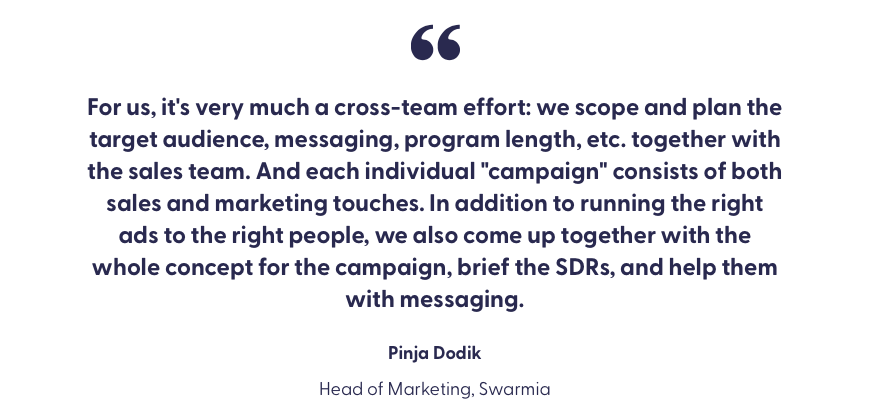
Solution 2: Use the right tools
The best prescription for failure for your campaign? Adding one more tool just "to run ABM". On average, every business is using 13 to 52 martech tools on a regular basis - are you sure you need to introduce one more interface to get used to?
One of the main success factors for any new initiative in sales and marketing is the amount of effort you need to put into it. If you make it easy for all the involved parties to access the necessary data and take actions quickly, you're halfway there.
It doesn't mean you don't need to buy new tools at all - if you don't have a buyer intent data platform or a visitor identification tool, it's going to be hard to extract any actionable insights for marketing and sales. The key here is to make this data available where your teams are ready to consume it, says Or Moshkovitz, Global ABX lead at AppsFlyer.
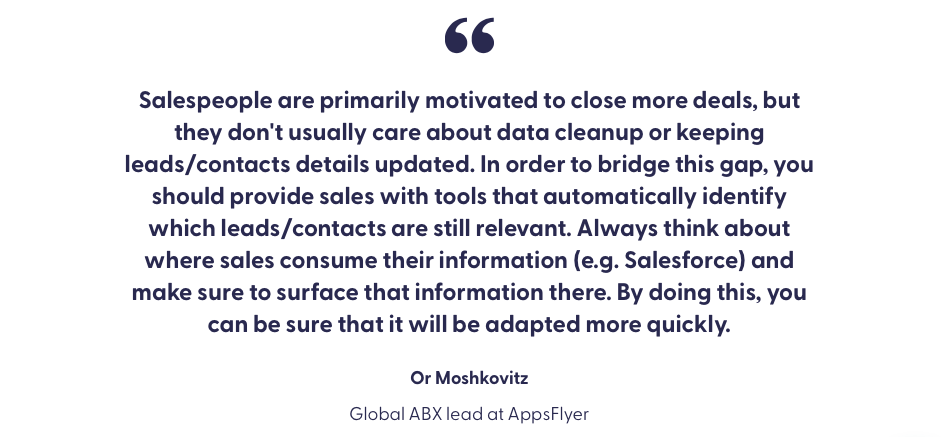
Depending on the channels and tech stack you decided to go for, your CRM can be enriched with different data types:
- Last website visit date. The quickest way to identify accounts that are interested in your solution right now - and get in touch.
- Buyer Intent score. Most intent data tools use scoring models that takes into account various types of first-party and third-party intent signals. Once an account reaches a certain score, it's probable that you should start soft outreach.
- Content and campaigns your prospects are interacting with. It will be useful for your SDRs to tailor talking points.
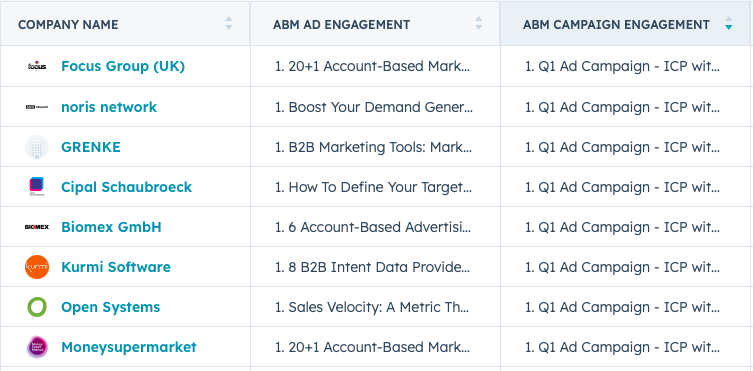
The data sources also need to be reliable and up-to-date - and you'll want to make sure the integration is working properly. Nothing can hurt more than having an outdated account list and trying to squeeze conversions out of it, says Adam Holmgren, Global Head Of Demand Generation at GetAccept.
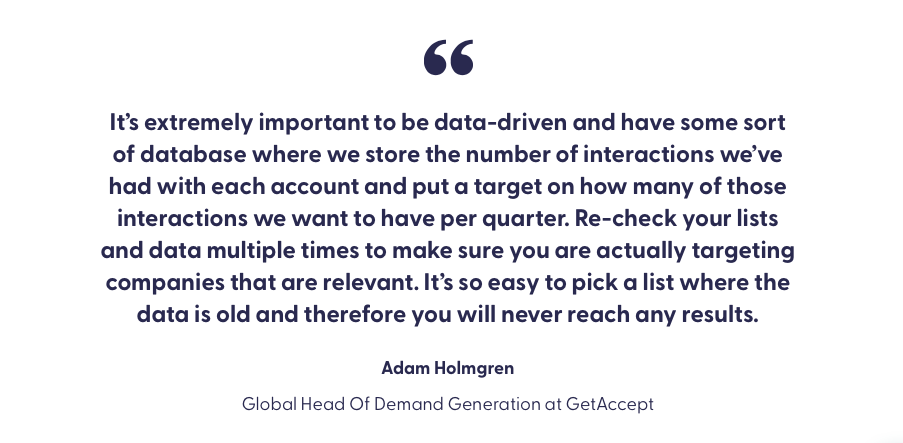
Challenge 3. Building Account Lists
As we're talking about account-based marketing, choosing the right accounts is the cornerstone. A lot of things can go wrong at this stage:
- You can go too broad and end up with a generic value prop that doesn't resonate with anyone
- You can spread too thin and run out of resources for execution
- You can narrow down too much and spend disproportionally big resources without making an impact
- You can start applying one-to-few tactics to a huge account list - or start running generic display campaigns for a list of 5 accounts (here's a useful graph to check what would be the best tactics for every type of ABM):
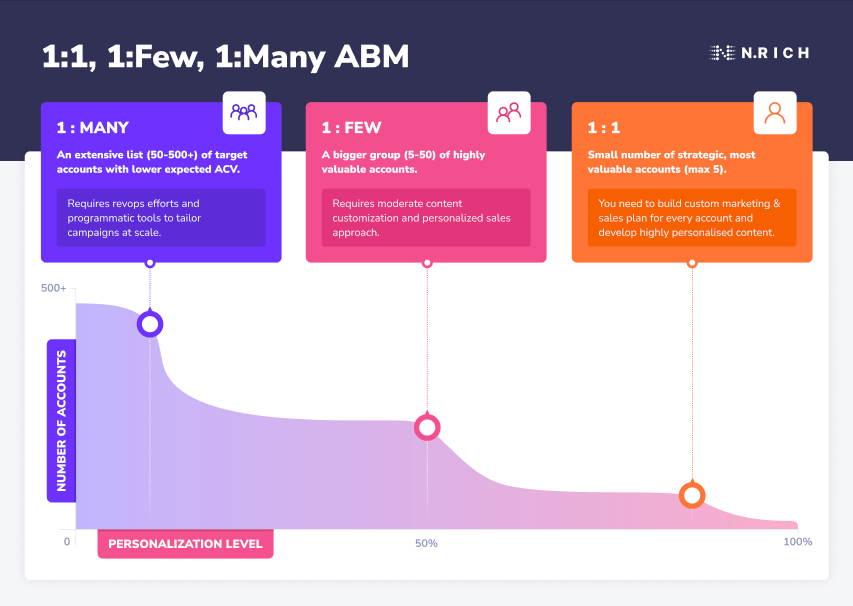
Akseli Matila, Head of sales at Advance B2B, sees it as one of the main obstacles they faced in setting up their ABM motion: "For us, I think, forming the TAM lists was really challenging. We looked at several tools for building our lists: most were not good, some were terrible, and some were OK but pretty much every tool was lacking somehow".
Solution: Nail your ICP - and don't avoid manual work
If you build a target account list before defining your ICP (Ideal Customer Profile), you put the cart before the horse. It can still produce some results - but it will take several iterations to polish the list, remove irrelevant accounts after spending a ton of money on them and identify the accounts that are worth adding instead.
Your ICP should reflect which companies have the highest probability to buy, with higher ACV and shorter time to sale. At N.Rich, we identify ICP automatically through sales velocity. As a result, you're getting parameters of companies that are expected to demonstrate better sales velocity (e.g. "50-250 employees, from SaaS and cyber tech industries, located in the US and Australia, interested in Marketing Automation and Demand Generation").
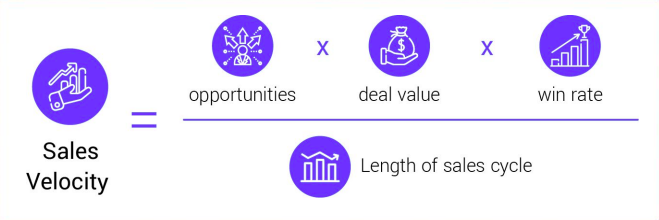
But for many companies, the ICP can't be fully identified without hours of manual work. Here are some examples we've heard while preparing this article:
- Companies with at least 25 sales reps
- Companies willing to switch from lead generation to demand generation
- Companies with women in the leadership
This is something you can't find with prospecting tools or databases. But after you spend hours and days on building this list, you'll have a bigger portion of your work done.
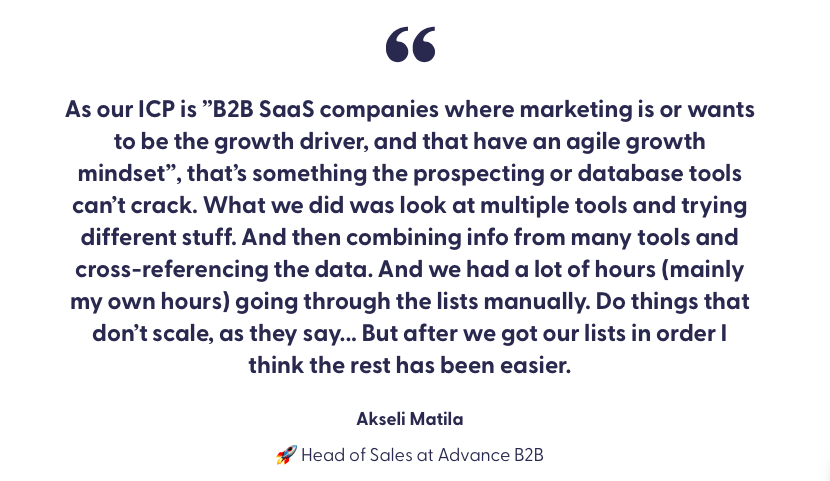
Challenge 4. Measuring The ABM Impact
It's tempting to come up with one and only metric to define the success of your ABM campaign. Logically, this would be revenue or closed won deals. However, with an average B2B sales cycle length of 83 days, you just can't afford waiting for 3 months to understand if the campaign was a success. This means you need to find more accurate ways to quantify the ABM impact.
Solution: Define short-, mid- and long-term metrics
If you got a buy-in from the leadership, sales, marketing, ops, and every other possible team involved, you all should be aware at this stage that ABM takes time. With this in mind, it makes sense to define the right metrics for every customer journey stage and monitor those to understand if you're moving in the right direction.
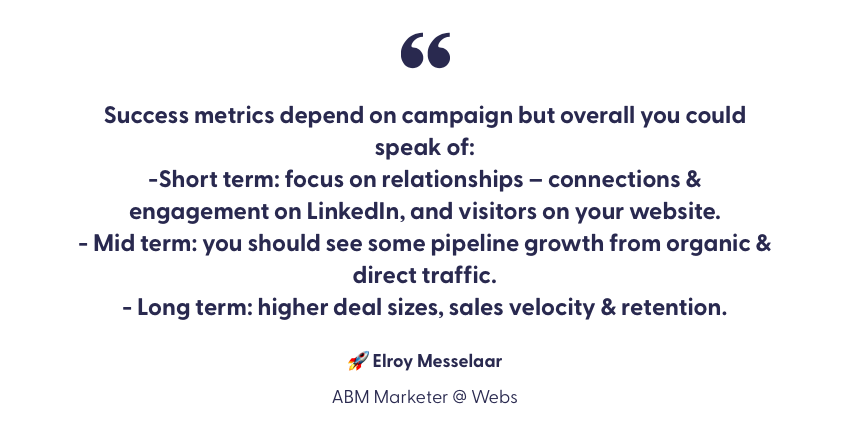
Bonus tip: when you define the metrics to focus on, think about the plan for every stage if anything goes wrong.
- If we see no traffic and engagement, what will be the other value props to test?
- If we see engagement and form fills but no bookings, who will be in charge of remastering the email sequences?
- If we see a boost in pipeline but no closed won deals, how do we define what is missing at the final stage?
- How do we decide that the ABM experiment failed and it's time to move on?
Useful Reads: How To Start And Scale ABM
Check our guides that will help you get your ducks in a row and create your best ABM campaign:
- One-to-one, one-to-few, one-to-many ABM - real-life examples to understand what is the best ABM tactic for you now
- Step-by-step guide to building a Target Account List
- Choose between dozens of ABM tools to help you hit your growth goals this year
- 3 ABM metrics to track (and 2 metrics to finally stop tracking)
Yulia Olennikova
Marketing Manager at N.Rich